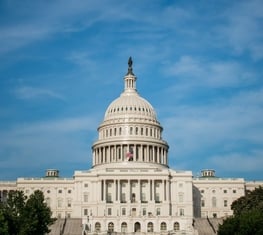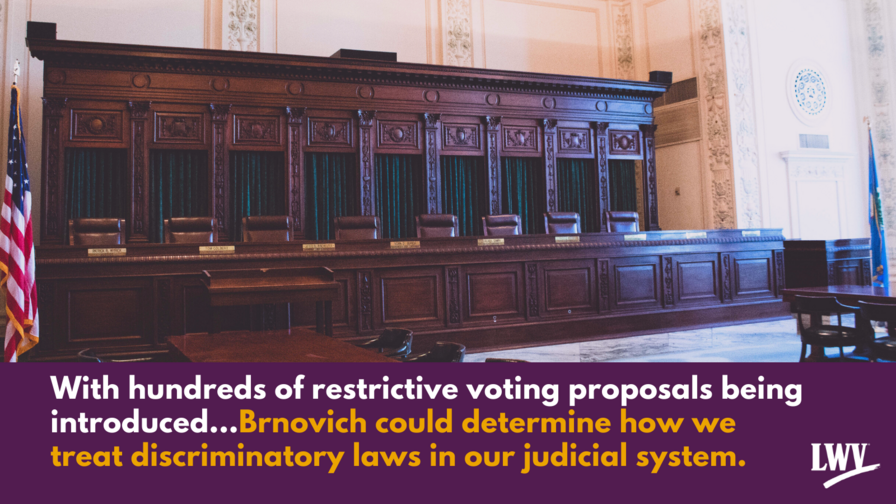Brnovich v. DNC and the Threat of Discriminatory Voting Laws
The Voting Rights Act (VRA) was passed in 1965 during the height of the Civil Rights Movement. It was designed to prevent states—particularly Southern states with a history of discrimination—from passing laws that either made it harder for Black Americans to vote or that made Black votes less impactful. It was a hugely consequential piece of legislation: data shows that the difference between Black and white voter registration in former Confederate states was almost 30 points in 1960, and by 1970 it had narrowed to single digits.
Brnovich v. DNC is a challenge under the VRA to two voting laws in Arizona: a law banning non-fraudulent ballot collection, and a law tossing out votes if a voter goes to the wrong precinct to cast their ballot. The plaintiffs in Brnovich argue that these laws violate VRA Section 2 (see below) by making its voting system unequal. The Supreme Court heard oral arguments in early March, and a ruling is expected by June.
While the Supreme Court has ruled in many cases involving the VRA, it has never directly spoken to the part at issue in Brnovich v. DNC: the “vote denial” portion of Section 2. In 2021, Section 2 is more important than ever. In the aftermath of the 2013 ruling of Shelby County v. Holder, Section 2 is the only tool voting rights advocates can use to fight discriminatory laws. With hundreds of restrictive voting proposals being introduced following the 2020 election, Brnovich could determine how we treat discriminatory laws in our judicial system.
The Voting Rights Act
Litigation to protect minority voters under the VRA focuses on two sections of the law, and the two sections function slightly differently:
- Section 2 makes it illegal for states to pass any law that “results in a denial or abridgement” of the right to vote “on account of race or color.” This can happen in one of two ways.
- Vote Denial: A state can pass a law that makes its voting system “not equally open to participation” for minority voters. For example, if a state passes a law removing all polling places from areas where voters are almost all Black, it creates an unequal voting system. The Supreme Court has never ruled on any case involving this “vote denial” provision of Section 2, which is at issue in Brnovich v. DNC.
- Vote Dilution: A state may draw districts in a way that gives minority voters less power “to elect representatives of their choice.” For example, a state can try to spread minority voters out across districts to give them as little voting power as possible. The Supreme Court has ruled on many “vote dilution” cases over the last 50 years.
- Section 5 prevents certain states—those with a history of discrimination—from changing its voting system without permission from the federal government. For those states, the federal government gives permission only if the law is not discriminatory. From 1965 to 2013, there were “coverage maps” in place that showed which states had to go through this preclearance process at any given time. However, in Shelby County v. Holder the Supreme Court found that the “coverage map” Congress was using was unconstitutional. Because Congress has not drawn a new coverage map in response, almost no states are required to obtain preclearance before changing their voting laws, meaning that Section 5 is rarely, if ever, used today.
Until Shelby County, Section 2 and Section 5 were both powerful tools that the federal government could use to stop states from passing laws that made it harder for minority Americans to vote. States that historically discriminated against Black and other minority voters couldn’t make any changes without getting clearance from the federal government. And even in the states that were not “covered” under Section 5, individual voters and groups could bring lawsuits challenging voting laws that impacted minorities.
After the Supreme Court struck down the coverage map in Shelby County, Section 2 became much more important: it was the only tool left for voting rights advocates to use to challenge discriminatory laws, even in states with a history of discrimination.
Brnovich illustrates this well. Arizona was one of the states included in the Section 5 “coverage map” prior to Shelby County, meaning it needed to get permission from the federal government to change its voting practices. For example, Arizona tried to ban non-fraudulent ballot collection in 2011 and the federal government denied preclearance, citing evidence that the law was intended to discriminate against Hispanic voters. But post-Shelby County, without Section 5 enforcement from the federal government, Arizona was able to pass a very similar law banning ballot collection. That means voters must use Section 2 to bring suit after the law has already passed, as they did in Brnovich.
As mentioned above, the Supreme Court has never heard a case involving the “vote denial” part of Section 2, so it has never decided some important questions about how it applies. The two most important open questions are:
- Is it constitutional? There are limits to how far Congress can go in protecting voting rights in state-run elections, and if Section 2 is too much of an infringement, it may be struck down entirely.
- How do courts decide if a law denies voters the right to vote on account of race? Is it enough to show that the law impacts minority voters at a higher rate than white voters, or do you have to show that the state intended for the law to do so? How do you prove intent? What if the state had other goals in mind, like election security? Even if the Court decides that Section 2 is constitutional, it may set such a high bar to proving discrimination that claims never actually succeed.
These are the questions the Supreme Court must answer in Brnovich, and given Section 5’s gutting, the answers to these questions will define how successful states’ voter suppression efforts are going forward.
Read more about how the VRA works.
2020 Election: Baseless Election Fraud Claims and Restrictive Bills
Compounding this issue is the influx of restrictive voting bills passed in 2021 following an election with record turnout. As of February 19, state lawmakers had introduced over 250 bills that restrict voting, concentrated in states that were previously covered by the Section 5 preclearance map, i.e. states with a history of voting discrimination such as Georgia and Arizona. States are justifying the laws by claiming that there was widespread voter fraud in the 2020 election. The problem? According to the Department of Justice, numerous courts, and experts, there was no election fraud at all.
Georgia and Arizona are also notable because they are the two states with historic election results fueled by minority voting. For example, 60% of registered Black voters voted in the 2020 election in Arizona, up from 46% in 2016. Many people speculate that this is why Georgia’s Senate seats went to Democratic candidates despite the state being known as a conservative stronghold. The influx of voter restriction laws, in that context, presents a concerning reality: state legislatures may be passing laws making it harder for minority voters to vote not because of fraud, but because they didn’t like how many minority voters were able to cast a ballot in the last election.
There are two background narratives working together to make Brnovich hugely consequential. States — including many of the states that were covered under Section 5 and have a history of discrimination against Black and other minority voters — are capitalizing on baseless election fraud claims in order to pass hundreds of discriminatory suppression laws. And because of the Supreme Court’s attack on Section 5, Section 2 is the only mechanism left to challenge these laws. As a result, Supreme Court’s ruling in Brnovich will decide whether voting rights advocates will be able to successfully challenge discriminatory voter suppression laws, or whether states will be able to further erode the protections put in place by the Voting Rights Act.
Restoring the Voting Rights Act
Shelby County may have weakened the VRA’s protections, but we have an opportunity to restore and strengthen them. If passed, the John Lewis Voting Rights Advancement Act (which President Biden voiced his support of in his recent joint address) would provide new criteria for the type of preclearance required by Section 5, as well as procedures for states to prove that preclearance is not necessary. This would restore the government’s ability to review new voting laws in states with a history of voter discrimination.
The John Lewis Voting Rights Advancement Act is expected to be introduced to Congress in the upcoming year. Once it is, let your Representatives know that you support it. The League stands behind this necessary legislation and will continue to provide updates on our fight for voter equality. We will also continue to provide updates on the status of Brnovich, and encourage you to watch this crucial battle closely.
The Latest from the League
Brnovich v. DNC is a case before the Supreme Court addressing the collection of ballots by third parties and the counting of provisional ballots cast outside of a voter’s designated precinct.
We thank President Biden for calling on Congress to pass the For the People Act and the John Lewis Voting Rights Advancement Act, and we echo that call.
The Voting Rights Act of 1965 was one of the most important pieces of legislation of the 20th century. But in 2013, the Supreme Court gutted important sections of it in Shelby County v. Holder.
Sign Up For Email
Keep up with the League. Receive emails to your inbox!
Donate to support our work
to empower voters and defend democracy.





